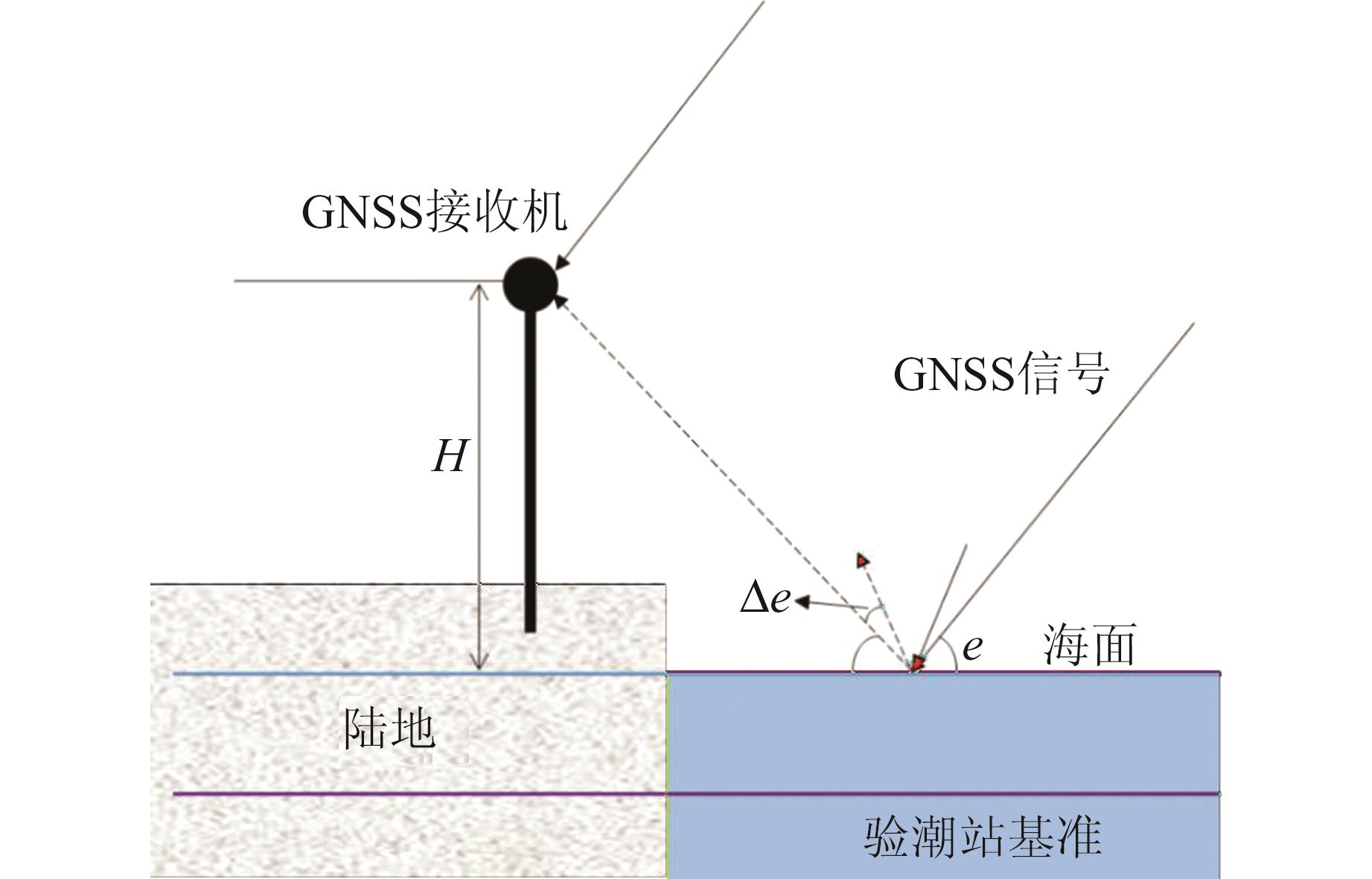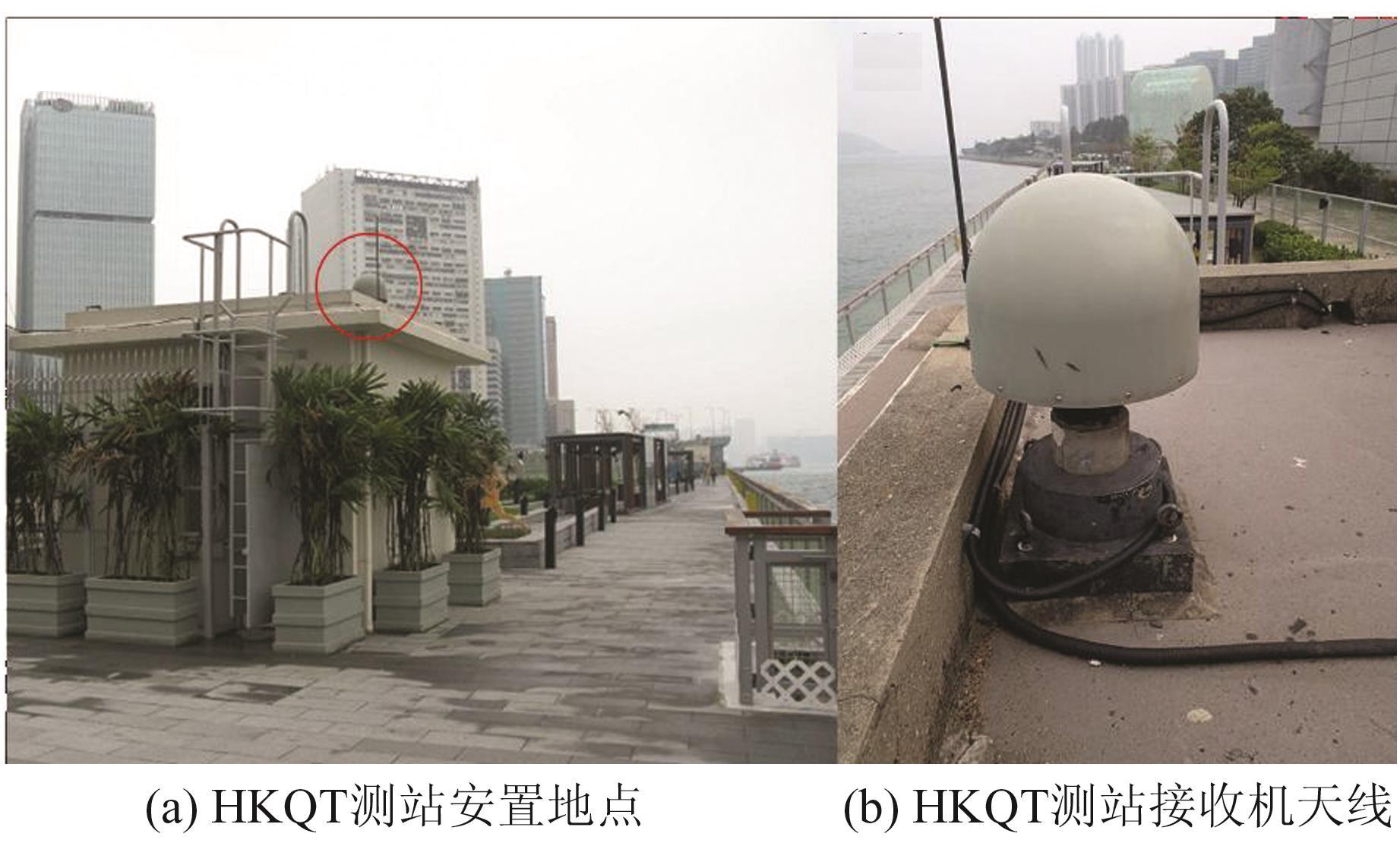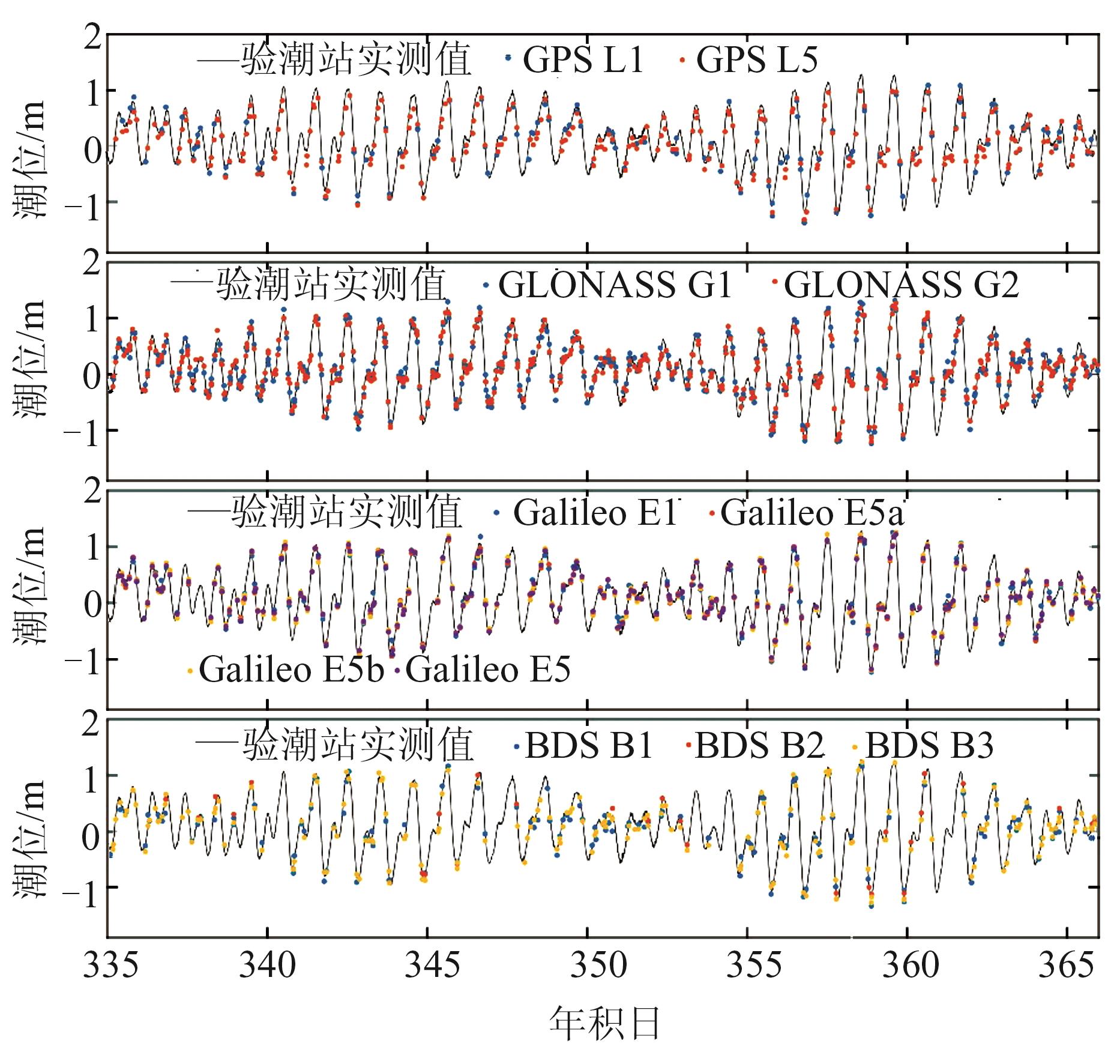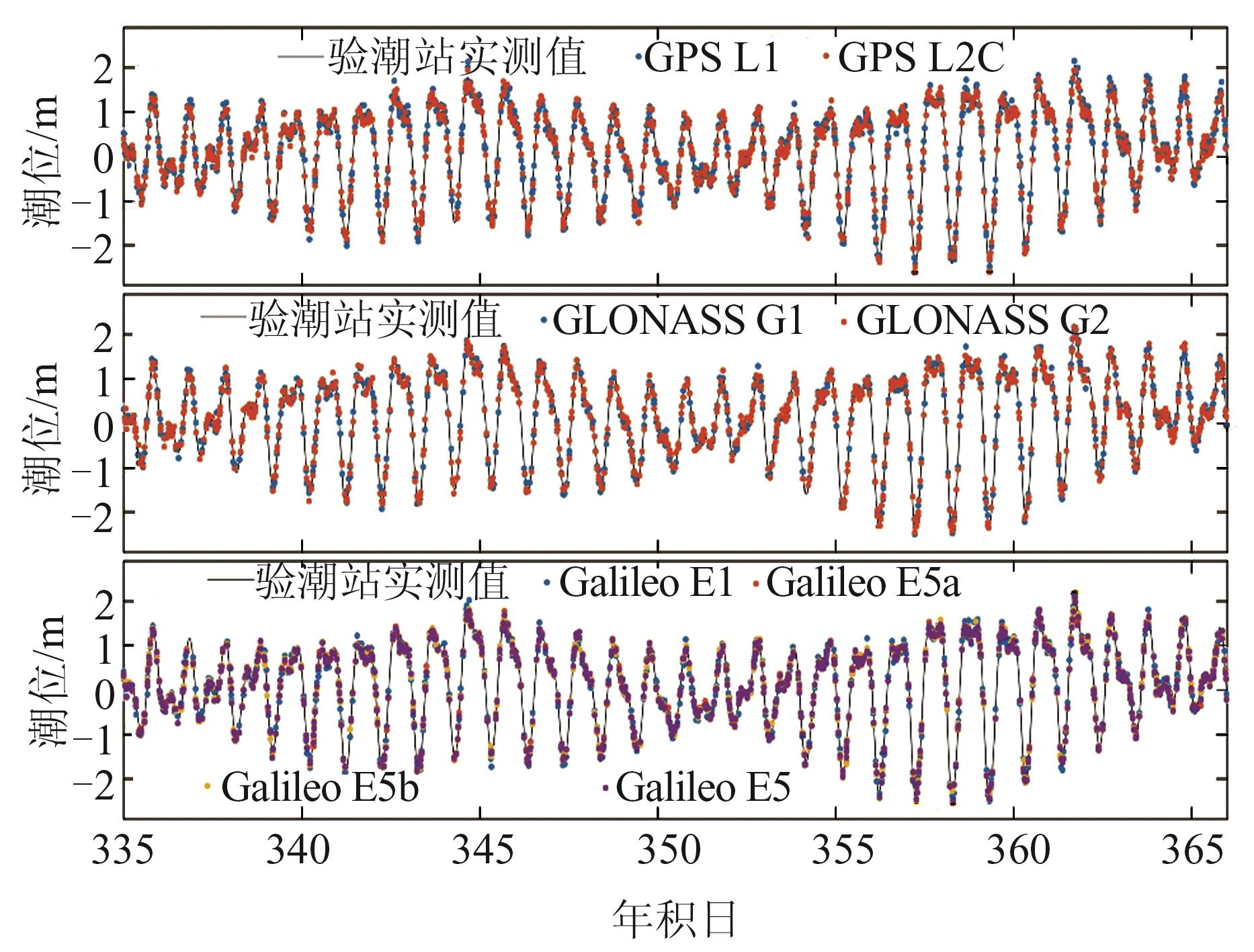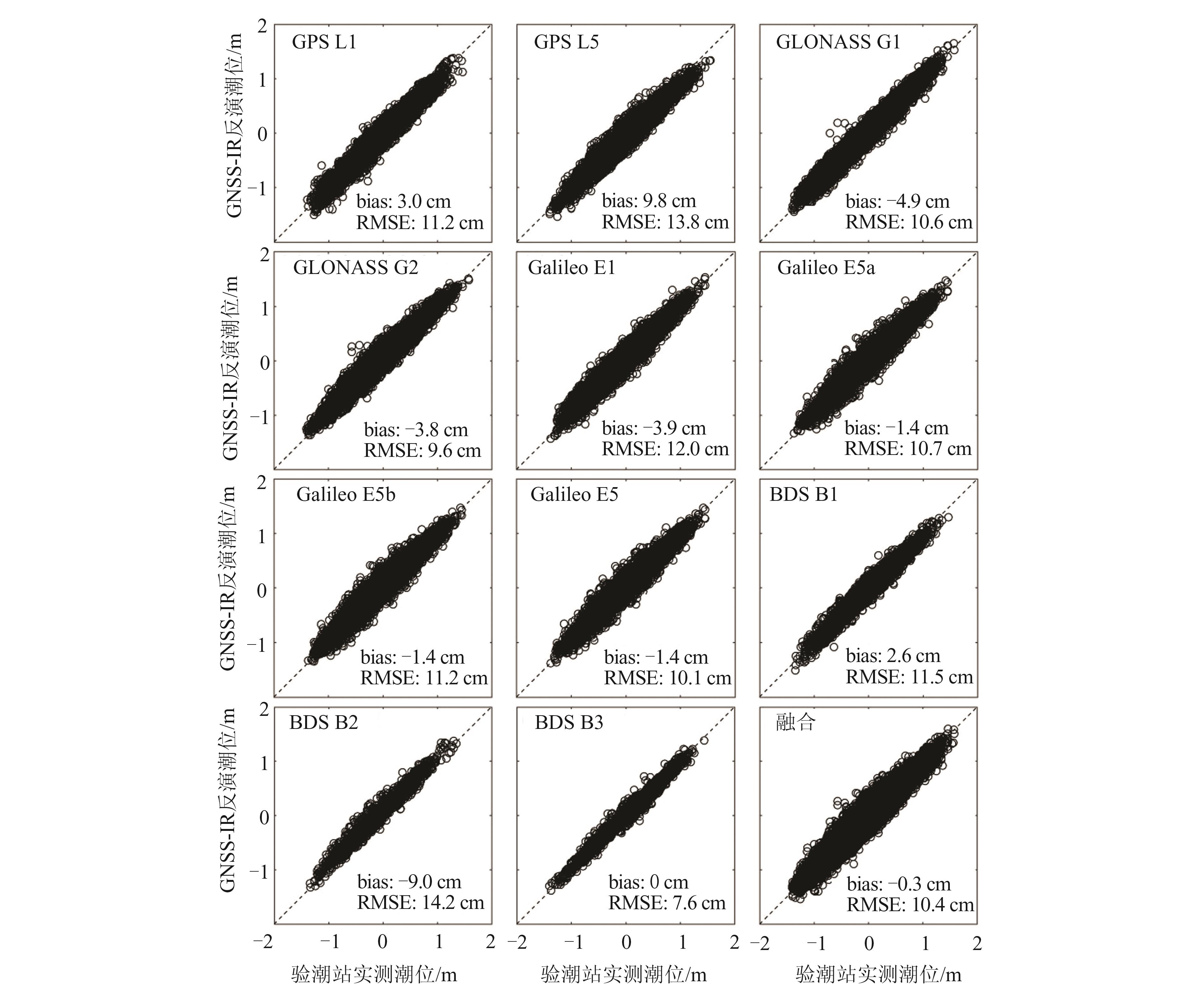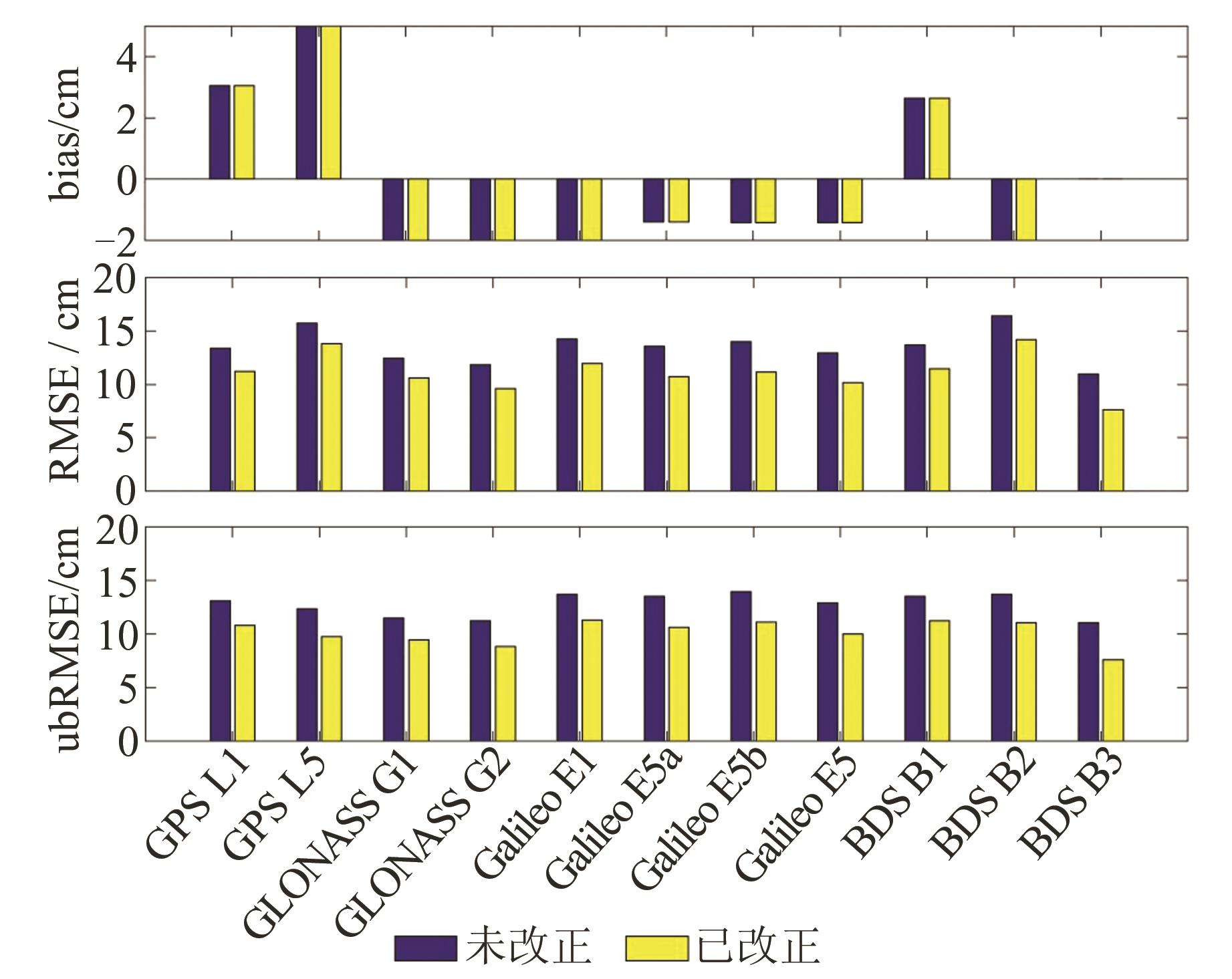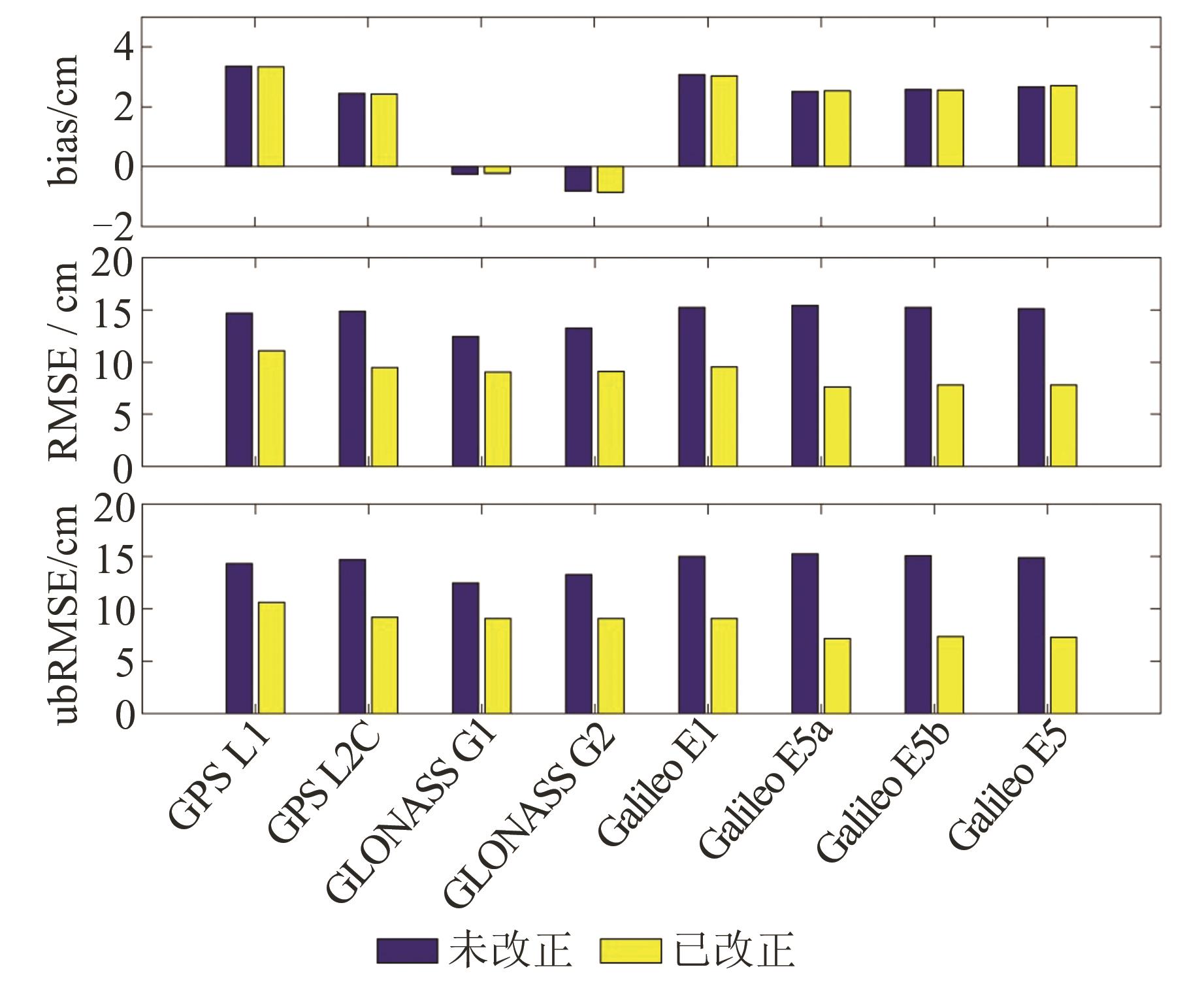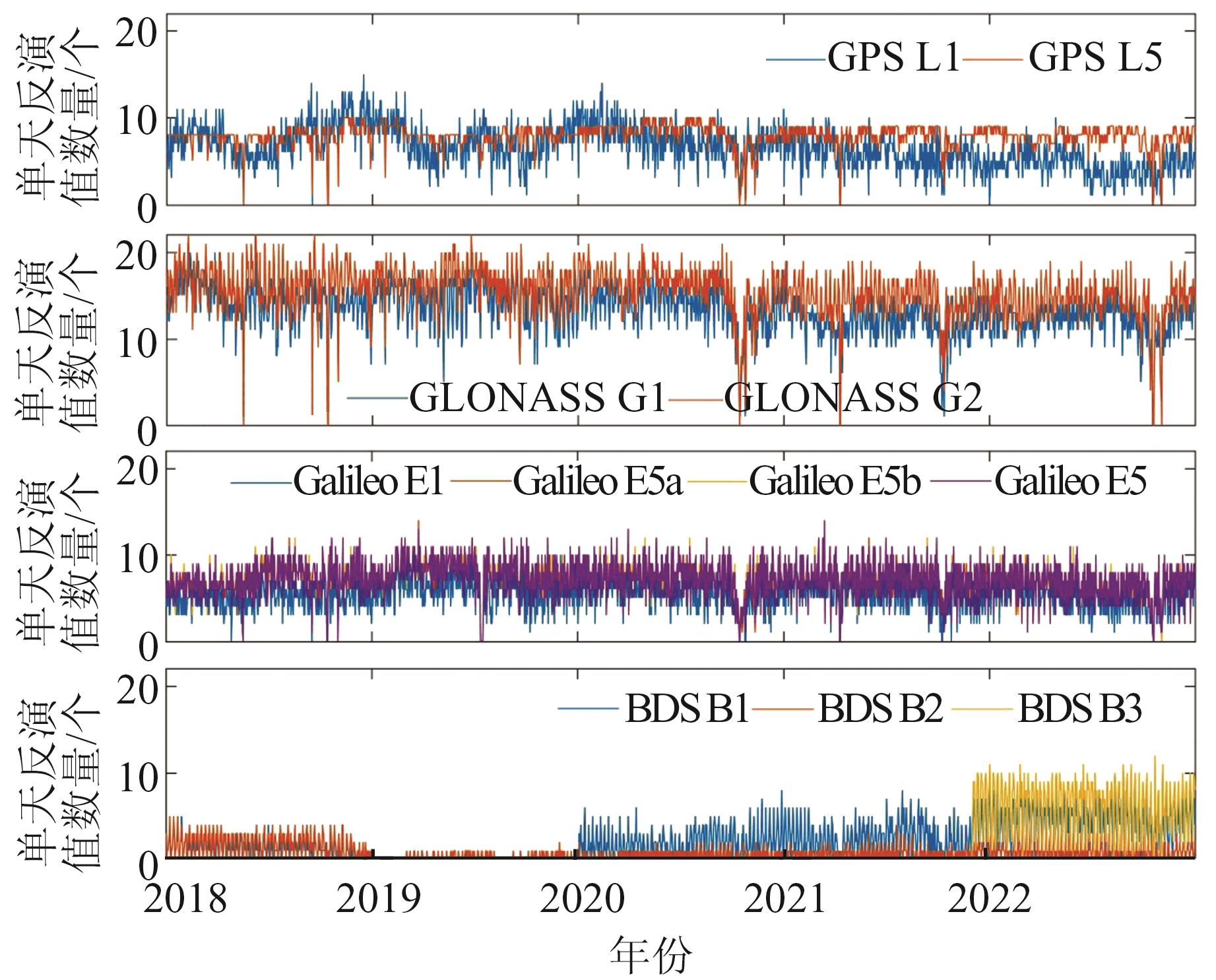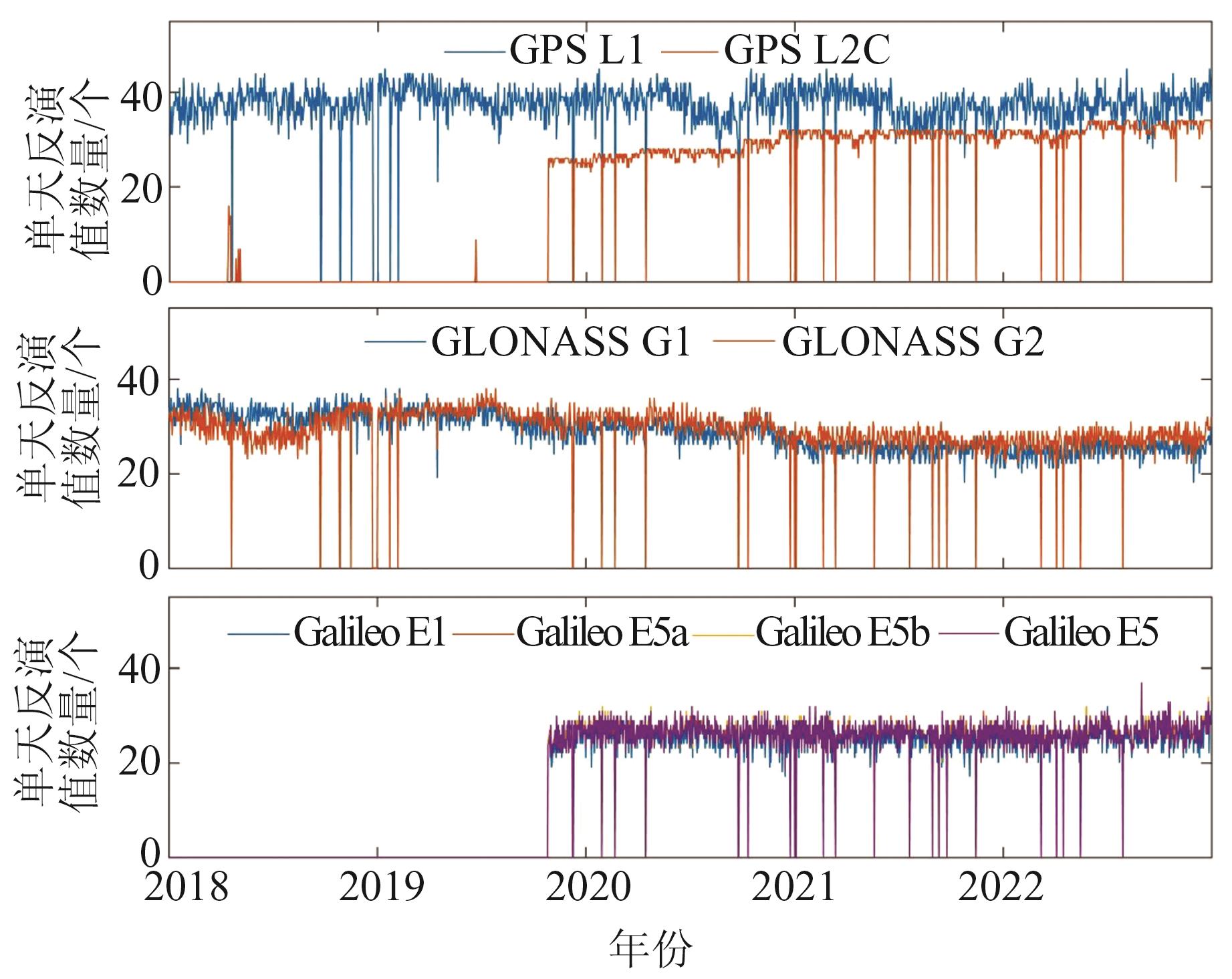Comprehensive Comparative Analysis of Long-Term, Multi-mode, and Multi-frequency GNSS-IR Tide Inversion
-
摘要:
海平面变化对海岸生态环境和人类生存发展有着重要影响,对海平面进行监测是全球气候变化和海洋灾害监测的重要内容。利用全球导航卫星系统干涉反射测量(global navigation satellite system interferometric reflectometry, GNSS-IR)技术分析了4大卫星导航系统11个频段的数据,反演了中国香港HKQT和美国西雅图SC02测站2018—2022年长时序的潮位结果,并进行了潮汐调和分析和长期变化趋势估计。结果表明,不同频段反演海面高的精度有所差异,经过海面动态误差改正后,精度在10 cm左右,不同接收机和不同环境会导致同一频段有不同的精度表现。海面动态改正能有效降低GNSS-IR潮位反演误差,以无偏均方根误差计算其平均精度提升了20.5%。通过多模多频数据提高了海面高反演的时间分辨率,并在一定程度上提升了数据的精度和连续性。潮汐调和分析结果表明,11个频段的振幅结果能够与验潮站结果很好地吻合,总体差异小于1 cm。但是,部分频段部分潮汐项的相位结果存在较大差异,这与单一频率潮位反演结果的时间分辨率较低有关。长期趋势分析结果表明,香港近海存在约6.0 mm/a的海平面上升,西雅图近海存在约4.0 mm/a的海平面下降,与验潮站结果吻合较好。试验结果不仅评估了多模多频GNSS-IR技术在监测海平面变化上的性能,而且揭示了海平面的长期变化趋势,这对于海洋灾害监测和海洋学研究具有一定的参考意义。
Abstract:ObjectivesSea level changes have significant impacts on coastal ecosystems and human survival and development. Monitoring sea level is an essential part of global climate change and marine disaster surveillance.
MethodsThis study uses global navigation satellite system interferometric reflectometry (GNSS-IR) technology to analyze data from 11 frequency bands across four major satellite navigation systems, inverting for long time series of tidal level results from 2018 to 2022 at HKQT station in Hong Kong, China, and at SC02 station in Seattle, USA, and performs tidal harmonic analysis and estimates long-term change trends.
ResultsThe results indicate that the accuracy of sea level inversion varies among frequency bands. After correcting for dynamic sea level errors, the accuracy is around 10 cm. Different receivers and environments can lead to varying accuracy performances in the same frequency band. Dynamic sea level correction effectively reduces GNSS-IR sea level inversion errors, with an average precision improvement of 20.5% in terms of unbiased root mean square error. Multi-mode multi-frequency data can enhance the temporal resolution of sea level inversion, and improve the accuracy and continuity of data. Tidal harmonic analysis shows that the amplitude results across 11 frequency bands align well with the tide gauge results, with overall differences less than 1 cm. However, some frequency bands show significant phase discrepancies in certain tidal components, related to the lower temporal resolution of single-frequency sea level inversion results. Long-term trend analysis indicates a sea level rise of about 6.0 mm/a near Hong Kong,and a sea level decline of about 4.0 mm/a near Seattle which aligns well with tide gauge results.
ConclusionsThe findings of this paper not only assess the performance of multi-mode multi-frequency GNSS-IR technology in monitoring sea level changes, but also reveal long-term trends in sea level. It can provide valuable references for marine disaster monitoring and oceanographic research.
-
Keywords:
- sea level /
- long-term data /
- multi-mode and multi-frequency /
- GNSS-IR /
- trend change
-
舰船目标作为河流与海洋的主要运输载体,对其进行定位和监测在军事侦察、资源生产管理、环境保护等领域都具有重要意义[1-5]。舰船目标检测作为海洋监测的一项重要技术,是进行舰船目标跟踪、识别的前提,在军事及民用领域都有着广袤的应用前景。随着航天技术的飞速发展,利用遥感进行舰船目标检测具有大范围任意区域观测、高时效性、数据获取高性价比等优点,是进行舰船目标感知的绝佳手段。
舰船目标实时、准确的态势感知需要结合海、陆、空大量传感数据进行探测与分析。舰船自动识别系统(automatic identification system,AIS)是最常见的舰船跟踪系统[5],它能够将舰船的位置与属性信息长时间持续地记录传输,是监测合作区域运动舰船目标的重要工具。此外,基于图像信息进行舰船目标解译,例如合成孔径雷达(synthetic aperture radar,SAR)[6]、热红外传感器[7]、光学传感器[8-9]等数据,是进行大范围舰船目标探测的重要手段。不同传感器类型都有其自身的优点和缺点,能够在不同时间、天气条件、监测场景、覆盖范围、更新频率、检测粒度等方面发挥各自的优势。SAR图像具有不受天气、云雾干扰,图像中船身金属反射特性区别于周围水面的特性,已成为海上舰船目标探测的主要手段。热红外图像通过成像对象本身的发射值来区分目标,在夜间的舰船目标监测中发挥着一定的作用。光学床图像中基于序列图像、视频图像以及基于成像延迟的单幅凝视卫星图像进行运动舰船目标检测已在动态舰船目标感知中得到了成功应用;基于高分辨率可见光的图像数据对近岸复杂区域的舰船目标进行定位识别也在舰船目标分析识别中发挥着重要作用。随着大量光学传感器的广泛使用,高空间分辨率(以下统称高分)的可见光图像数据量以几何级数增加。由于其具有获取经济便捷、细节清晰、成像与自然图像相似等优势,既能开展大规模数据下的验证评估,又能够借鉴成熟的计算机视觉目标检测方法论,基于高分可见光影像进行舰船目标检测已经成为当前主要的热点领域,相关研究呈现爆发式的增长,见图 1。
本文聚焦高分图像舰船目标检测技术,对近十年国内外有影响力文献(中文文献包括中国知网上核心期刊、硕博士论文,共718篇;英文文献包括科学引文索引(science citation index,SCI)论文、有影响力的会议论文,共234篇)的研究主题进行了统计分析。从研究主题来看,随着获取到图像的数量与质量提升,舰船目标从特殊场景目标变为现在的作为典型遥感目标检测的一部分开展研究;从早期的聚焦于海面影像的舰船定位与提取(包括云、海面、海浪等主题)逐渐转向复杂环境下的舰船检测(包括复杂场景、多尺度、类内变化多样等主题)研究;检测方法从人工设计、层层筛选定位检测(如疑似区域、部件、虚警等主题)发展为当前主流的基于卷积神经网络、一体化定位检测(包括深层特征、包围框、锚点等主题)。近年来,已有学者开展了有关可见光遥感影像舰船目标检测综述分析,普遍认为高分可见光遥感图像可以为精确的舰船感知提供高价值的特征及定位识别信息,但同时表明当前仅利用高分可见光图像进行舰船监测仍以检测为主,进行大范围、长时间、高精度、细粒度的舰船属性分析非常困难,需要结合多传感器数据进一步探究。现有方法模型聚焦于特定数据、特定场景下的目标检测研究,在实际不同传感器、不同复杂环境中开展鲁棒的舰船目标检测依然面临严重挑战。
为了比较全面地回顾近十多年高分可见光图像舰船目标检测领域的研究进展,本文从舰船检测的方法体系与发展历程概述、代表性方法归纳、检测精度评估等方面对高分可见光图像舰船检测的进展进行回顾和总结,并对高分可见光舰船检测未来研究趋势进行了展望。
1 高分可见光遥感图像舰船检测的方法体系
由于高分可见光遥感图像空间分辨率不同、覆盖的场景变化多样,许多学者为此开发了多种多样的舰船目标检测方法。本文从检测粒度、建模方法两方面对这些方法进行总结,如图 2所示。
随着图像空间分辨率的提升,舰船目标所呈现的结构纹理信息更加丰富,目标解析层次从区域级识别(图像块分类识别是否是舰船目标)、像素级提取(按一定规则获取目标像素)到对象级目标定位(获取实例级对象的位置),在舰船目标自动化解译中得到有效应用。从检测模型尤其是舰船区域/目标特征建模来分,高分可见光图像舰船目标检测可以分为基于人工特征建模的方法与基于深度特征学习的方法两类。前者利用专家知识规则对舰船目标进行特征建模表达(大量的低层、中层特征),实现舰船目标的有效判别。后者依托于人工智能技术,利用深度神经网络自动学习目标不同层次的特征进行舰船目标的检测定位,目前在遥感图像目标检测中得到越来越广泛的应用。由于舰船目标分布的特殊性和广泛性,从检测场景来分,舰船目标检测可以分为面向特殊场景的舰船目标检测与一般场景的舰船目标检测两类。
2 高分可见光遥感图像舰船检测发展历程
高分可见光图像舰船目标检测的任务是从图像中定位识别出舰船目标实例,需要解决目标“是什么”“在哪里”两大问题,遵循目标疑似区域定位、目标精细定位检测由粗到细的检测流程。在数据预处理完成后,首先进行大范围的图像舰船目标疑似区域定位,快速获取有限候选区域;然后通过对舰船目标特征精细建模在候选区域内进行进一步分析确认,完成对舰船目标的定位和判别;最后经过后处理步骤进一步剔除冗余目标,并对检测结果进行精度评价。
遥感图像目标检测方法的演化史就是对地观测技术、信息技术的发展史,遥感图像空间分辨率的提升、计算机视觉的发展、并行计算的突破,都对高分可见光遥感图像目标检测技术的发展产生了深入影响。本文对2010—2020年高分可见光图像舰船检测方法从年代、图像分辨率、检测场景、处理流程等维度进行了分析归纳,如图 3所示,分为以下3个典型的发展阶段:(1)基于中高分可见光图像舰船目标判别提取时期。2010年左右5 m分辨率的图像是用于可见光图像舰船检测的主要对象,基于底层特征的对象分析是舰船目标检测的主要思路,利用舰船目标区别于水面的独特亮度、纹理与形状特性进行统计、学习与判别、分类,从而实现中高分辨率、较为简单场景的舰船目标检测。(2)基于高分可见光图像舰船目标特征建模检测时期。2013年左右,2 m分辨率的可见光图像获取难度降低,图像中大量中小型的舰船目标信息变得丰富、容易识别,视觉注意机制、中层特征编码等机理研究成为视觉领域的热点主题,前者在大幅面遥感影像的舰船目标定位,尤其是疑似区域定位方面得到了成功应用;后者通过对底层特征的有效高层建模弥补了语义鸿沟,广泛地使用在复杂背景、类内变化多样的舰船目标建模中,从而实现高分图像中较为复杂区域的舰船检测。(3)基于深度学习的高分可见光图像舰船目标检测时期。随着深度学习在计算机视觉领域取得了革命性的成功[10],以及2016年左右大规模高分可见光图像舰船目标检测数据的涌现,舰船目标检测的整体研究思路迅速向基于深度学习的方法演变。舰船检测流程也由分步进行向当前的一体化定位检测的方向发展,卷积神经网络(convolutional neural networks,CNN)被广泛应用,其中基于分类的检测框架[11]与基于回归的检测框架[12-14]引领着目标检测体系发展潮流。
目前,基于高分可见光遥感图像的舰船检测在速度、精度、场景适应性上都得到了巨大的提升,但距离实际复杂场景图像中高效的舰船目标检测仍然有一定差距。高分可见光图像舰船目标检测存在以下难点:(1)舰船目标区域定位困难。在大范围遥感图像上,舰船目标通常只占很小一部分,冗余、复杂的背景环境(如大量无关场景、破碎岛屿、凸堤、陆地目标等)干扰给舰船目标区域有效定位带来了巨大挑战。(2)舰船目标表征难。舰船目标周围复杂的背景(云、浪、岛屿、海杂波、尾杂波、黑白极性、沿岸泥沙、光照、阴影等干扰)导致舰船目标被遮挡、弱化,舰船目标本身分布的多样性(多尺度、多类别、多形态、密集排布等干扰)导致目标特征对齐困难,这些都使得舰船目标的特征类间区分性、类内统一性建模非常困难。(3)舰船检测方法普适性不高。现有的高分可见光图像舰船检测标注数据集中,目标在尺度、类型、场景、视角分布上相对有限,舰船目标类型呈长尾特性分布,当前检测模型对难分目标,以及分布外的不同传感器、不同拍摄环境图像目标检测适应性差,难以满足大范围的自动化检测应用需求。
3 高分可见光遥感图像舰船检测方法归纳分析
3.1 基于人工特征建模的舰船检测方法
此类舰船目标检测方法逐步去除干扰因素,对于大幅面的高分可见光图像,一般需要进行舰船疑似候选区域提取从而获取目标区域,并在此基础上进行舰船目标检测定位得到精确的目标属性与位置信息。也有一些研究基于图像切片直接进行舰船目标检测定位。
3.1.1 舰船疑似候选区域提取
基于先验信息的海陆分离针对大范围水陆图像的舰船检测在有影像位置信息和相应的地理先验信息时,利用精确的地理信息辅助进行水陆分离是获取舰船目标候选区域的有效方法。其中先验信息包括港口地理信息、海岸线信息等[15],并通过精确的模板匹配或图像配准后分离出水域图像。此类方法的优点是分割效果准确稳定,不受场景、光照等因素影响。但同时缺点也很明显,当图像位置信息缺失或不准确、地理先验信息缺乏时,配准结果不再稳定,此过程就无法保证顺利进行。
基于分割的疑似区域提取对于灰度分布较为一致的水面区域,利用分割算法能够有效地实现大面积云雾去除、水陆区域分离、水面与舰船疑似区域分离,因此被广泛应用于舰船疑似区域提取。具体方法有基于全局阈值分割方法[16]、基于能量函数分割方法[17]、基于局部多阈值分割方法[18-21]等。此类方法能够有效地从简单场景图像中提取疑似舰船区域,但对于海杂波、大量碎云、海浪、小岛干扰较多的海面区域以及复杂的近岸区域,往往不能有效地进行分割,导致结果虚警和漏检都很高。
基于特征分析的疑似区域提取对于较为复杂的海面和近岸场景需要对目标进行有效特征建模来区分背景与疑似舰船区域。提取的特征大多具有一定的局部或全局不变性,如灰度[18]、颜色直方图[19]、纹理[20-22]、频域[23]、几何形状特征[24]等。此外基于生物视觉启发的视觉显著特征是一种特别的对比差异性特征,能够快速将少量舰船疑似区域从大范围的海面背景中区分出来。具体包括生物视觉注意模型[24-25,39]、频域显著模型[26]以及多种显著性融合特征[27]。特征判别方式包括统计判别方法[22,28,41-42]、决策方法[29]、异常分析方法[30]、特征学习分类方法[26-27,31-32]等。基于特征统计判别(尤其是基于显著特征判别)、异常分析的方法大多以像素为单位分析,易受不同环境因素变化的影响,同时对目标类内变化的适应能力较弱,适合分辨率较低、船体稀疏分布的目标候选区域提取。利用特征投票、决策或学习分类的方法能够一定程度上以对象为单位进行特征建模,但其提取结果受特征设计及数据影响大,很难产生较为通用的大范围复杂场景舰船候选区域提取方法。
3.1.2 舰船目标检测定位
在经过大量背景、虚警去除获取到有限的疑似舰船候选区域后,需要进一步对其进行精细分析,输出更为精细的舰船目标定位结果。此阶段面临的主要问题来自于与舰船区域相似的背景干扰(类间差异小),以及舰船内部多尺度、多类型分布偏差(类内差异大)。主要的方法包括基于统计判别的方法、基于投票判别的方法、基于特征学习的方法等。
基于统计判别的方法通过对舰船与非舰船目标的特征进行统计,基于聚类或相似性度量的方法进行舰船目标判别[20-22,33-34]。常用的特征有灰度、纹理、几何结构(长宽比、圆度、角点、边缘、形状轮廓等)等特征。此类方法基于对单个舰船的目标区域块进行分析,因此仅适用于海面场景、稀疏分布的舰船目标,对于复杂的舰船场景无法进行有效的统计判别。
基于投票判别的方法对于高分辨率的复杂近岸场景图像,基于部件表示的模型将舰船目标检测转化为利用一组对象组件、形状等特征进行相似性测量。在舰船检测中大多利用广义霍夫变换 [35-37]进行特征度量,再通过后续的投票获取最终的定位检测结果。此类方法对于平静水面场景的靠岸舰船能取得良好的检测提取结果,但并不能适用于各种复杂背景干扰如阴影、光照、海浪、云雾等,以及舰船目标多尺度、多姿态、多方向分布复杂的情况。
基于特征学习的方法为了适用于大范围、大规模的舰船目标定位检测,基于大量数据学习分类的方法被广泛使用。一些具有不变性质的特征[22,25,38-39]表示,如尺度不变特征(scale invariant feature transform,SIFT)、Gabor特征、梯度直方图(histogram of oriented gradient,HOG)特征、视觉显著特征等被广泛用于特征提取。为了弥补底层视觉特征与高层语义之间的鸿沟,基于中层特征编码建模的目标特征表征模型被广泛地使用,包括词袋模型(bag of words,BOW)[23,40]、稀疏编码[32,41-44]等。这类基于特征编码的方法能够较好地适用于复杂背景下的舰船目标判别,但大多是基于图像块的建模,因此不能进行目标的有效定位。后续基于部件模型(deformable part models,DPM)的方法[45-47]能够有效对目标进行各个部件的组合建模,从而实现目标的精确定位与检测。但这种方法需要将目标进行统一尺度的对齐,人工参与较多,对于旋转、尺度、类型差异大的舰船目标检测效果差。
3.2 基于深度特征学习的舰船目标检测方法
尽管基于深度CNN模型与传统的舰船目标检测模型在特征设计上有巨大差异,但整个检测流程后者对前者的影响深远。虽然基于深度学习的目标检测流程逐渐形成了一体化的目标检测体系,但传统方法尤其是后期特征编码学习的方法中的滑动窗口策略、多层次信息整合等思想依然在基于深度学习的舰船目标检测中起着重要作用。当前基于深度学习的高分可见光图像舰船目标方法依托于计算机视觉中目标检测领域的方法体系,在此基础上针对可见光遥感图像本身的特殊性、舰船目标的独特性进行进一步深化改进,推动着高分可见光遥感图像的舰船检测向着更加自动化、高精度、实用性强的方向发展。增强目标特征表征的有效性、多尺度定位的适应性、多姿态位置回归的稳定性、不同场景范围的鲁棒性等都是有效提升舰船目标检测性能的关键,现有的检测方法往往针对其中一点或多个点综合开展研究,本文将这4个方面的具体方法分别进行总结分析。
3.2.1 基于深度特征增强的目标特征表征方法
高分可见光遥感图像可以清晰地呈现一定范围内的目标及其背景,在带给目标更丰富细节特征的同时引入了大量的冗余信息。为了能将目标从大量复杂的负样本中分离出来,同时尽可能满足不同类型、尺度、姿态的目标表征,就需要提取更为有效的目标特征来提升目标判别的准确性。
除了加深网络层数外,增大卷积核的感受野(receptive field,RF)能够对更大范围的图像块(包括目标及其上下文)进行特征描述,从而有效提升CNN网络的特征提取能力。早期的一些方法直接利用大卷积核(如Alexnet[48])进行特征抽取,增强网络表征能力的同时给计算资源带来了极大挑战,因此后续发展的多个小卷积核代替大卷积核(Inception [49]系列)、空洞卷积(dilated CNN[50])、金字塔池化(spatial pyramid pooling,SPP[51])等方法被广泛用于视觉任务中。在舰船目标检测方法中,Zheng等[52]开发了多感受野卷积分组表征聚合模块,用于捕获超尺度特征的尺度不变性,提升模型对于舰船目标尺度变化的适应性。此外,各种上下文关联模块[53-54]被用来增强网络的舰船检测性能尤其是小目标的检测性能。
另一种能够辅助网络有效忽略无关信息,关注重点信息,从而加强网络对于目标及其相关上下文的模型为注意力机制。不同于单纯的特征设计,注意力机制通过显式的监督,将学习到的权重信息施加在特征上进一步强化对于目标表征更有用的特征。典型的视觉任务有关的注意力机制有通道注意力[55]、空间注意力[56]、混合域注意力[57]、全局注意力[58]等。在遥感目标舰船目标检测中,一些学者基于不同层次特征[59-60]、不同空间尺度的注意力[61-63]机制来提升目标的表征能力,取得了不错的结果。考虑到空间上的和全局的注意力需要的计算量很大,舰船检测中目前更多的是使用分割的结果来定位关键点或区域[64-66],以此作为进一步约束检测框架产生更高精度的目标定位检测结果。
此类方法能充分应用目标及其上下文信息进行丰富的特征建模,但同时也不可避免引入新的问题,如新引入的超参数的敏感性与鲁棒性,新增模块与检测定位网络如何联合优化等。
3.2.2 基于多尺度特征融合的候选区域提取方法
为适应不同尺度的目标定位与识别,便于并行运算,充分利用CNN网络特征层的多尺度特性代替多尺度图像多次进行不同尺度的统一区域定位与检测是一种更为快速有效的方法。特征金字塔网络(feature pyramid network,FPN)[67]是一种典型的联合自上而下的多尺度特征增强网络,通过使用更深的层探测较大的物体,使用较浅层在较大的尺度上检测小目标被广泛用于目标检测研究中。Li等[68]构造的HSF-Net将不同尺度的特征映射到同一尺度空间进行采样回归检测,高层特征能够有效检测大尺度目标的同时,底层尺度空间特征经过与上层特征的融合提升了对于小目标的感知能力。文献[69-71]基于FPN的结构或改进不同尺度特征层的连接方式如稠密连接、跳跃连接等进行多尺度特征融合的舰船检测。
与深度特征增强的目标特征表征方法尤其是上下文信息融合的方法不同,FPN系列的多尺度特征融合模型更强调在解码阶段将不同层的特征经过采样后与原先层进行融合,能够有效地将图像中不同尺度的目标进行统一学习,提升了舰船目标检测的速度;同时通过合理分配相应尺度的目标回归检测,有效地提升了目标检测的性能。如何构建强健的多尺度特征融合结构是此类方法的重点与难点,后续很多研究在此基础上探索更好的连接方式设计[72]或进行网络架构搜索(NAS-FPN[73])学习,以追求更高效、更高精度的目标检测性能。
3.2.3 基于目标精确位置回归的检测方法
遥感目标不同于一般自然图像与人脸目标检测数据集中的竖直排布,其目标位置分布是任意方向的。舰船目标的长宽比范围比一般的目标更为多样,且目标与目标之间、目标与背景之间干扰都非常严重,影响着舰船目标的准确定位与判别。使用传统的一般水平框回归会导致目标正样本区域存在大量背景干扰使得回归位置不准确,而在后处理过程中也可能因为水平框重叠度过高导致部分检测框被删除而导致漏检。基于此,遥感领域的学者开展了大量的基于更准确目标位置回归的研究[62,74-83],引领了独属于遥感领域目标检测的研究热潮。其中最直接的解决方法就是通过将水平的锚点(anchor)框进行旋转增强[74],以此更好地贴合旋转框定位检测任务。此类方法能够改善密集排布的舰船目标检测情况,但由于不可能穷举所有的可能角度,导致不能产生足够的与正样本比较贴合的正例,而且对于参数相当敏感,不容易学习,检测速度缓慢。后续有学者陆续提出了旋转池化区域推荐层[75-76],用于进行旋转特征学习定位。Zhang等 [77]直接利用旋转anchor进行两阶段的回归检测;Yang等[78]研究R3Det、SCRDet[62]等模型在生成初始更容易回归的区域后进一步细化对齐到精确的目标位置;Ding等 [79]通过设计一个可学习的RROI Learner模块,进行更高精度的锚点框生成。针对旋转框角度不连续的问题,Zhu等 [80]基于一种新的表示方法进行目标角度的可连续学习。
除了水平框不能很好贴合目标的问题外,基于锚点设计(anchor-based)的策略对于舰船这种具有极大长宽比变化的目标也不能很好地贴合(用传统的1∶1、1∶2、2∶1预设锚点产生的正样本很少)。一些学者基于数据集中的舰船尺寸统计[81],并以此选择合适的尺度分配进行定位检测;也有学者基于任意锚点(anchor-free)定位的思路,基于可学习的锚点预测模型[82-83]来灵活学习目标的位置。对于常用的位置回归损失与真实目标预测回归框不完全对应导致回归偏差的问题,提出了基于改进目标检测分类与回归的损失函数[79,82-83]、多次逐步精细回归[80,84-85]以及改进的非最大值抑制(non-maximum suppression,NMS)[59,86]等方法进行更为有效的特征学习、模型训练以及结果优化,从而达到更高的检测精度。
此类方法通过深入分析影响舰船目标定位精度的因素,利用增强目标区域对齐的方法进行检测性能优化,有效地提升了目标定位与检测的上限。如何保证回归过程的稳定性以及提升定位的泛化能力是此类方法面临的主要问题。
3.2.4 舰船目标检测模型自适应检测方法
尽管多尺度特征金字塔的方法能够一定程度上解决目标的尺度问题,但由于遥感图像舰船目标尺度差异极大,当前将图像裁切缩放后统一尺寸地输入检测网路不可避免地导致部分过大或极小的目标无法得到有效的学习。为了缓解这种目标尺度分布规模不平衡问题,如何合理地进行多尺度候选区域获取,使得不同尺寸的目标都能够尽可能在一定的尺度范围内被检测到是此类方法的重点研究目标。Li等[87]以及You等[88]在统计小尺寸舰船目标分布的基础上进行基本图像块的确定,并基于显著性评估的方法对图像中的大尺寸船图像块缩小后进行统一目标尺度分布下的定位与检测。Yu等[89]在获取较为准确的舰船候选区后,对每个区域基于中心裁剪的方法获取多尺度图像,并以此输入卷积网络中进一步进行目标判别。Wang等[90]采用不同的块尺度对大规模舰船数据集中的目标进行检测,计算不同块尺度下不同目标检测结果的平均精度,并统计最优值获取对应的图像尺度进一步用于自适应的舰船检测以提升整体检测精度。此外,无论是模型训练还是测试阶段,随机裁剪、多尺度图像训练/测试都能极为有效地提升检测方法对不同尺度分布的目标适应性[91]。
针对实际应用特别是可见光卫星图像上的舰船检测范围相当大,真实舰船分布的区域往往只占很小一部分,直接进行目标检测由于大量的冗余背景使得正负样本分布极度不平衡,严重影响检测的准确性和时效性。因此如何自适应提取大范围图像上的舰船目标疑似区域尤为关键。此类型方法目前的研究思路都是利用舰船目标本身的场景关联特性,利用先验地理信息[88]进行港口场景区域的定位实现疑似图像区域的提取,在此基础上进一步执行舰船目标检测。
此类方法可以显式地适应不同大小、场景的舰船目标以提升检测精度,但需要有专业知识辅助学习,而对于不同场景图像之间尺度参数的适应性及迁移性研究需要进一步探索。
3.3 高分可见光遥感图像舰船目标检测精度评估
对于舰船目标的检测结果评估是高分辨率可见光遥感图像目标检测的重要一环。目前对于遥感图像舰船检测性能的定量评估主要基于对象级统计,检测的结果可能会出现正确检测、错误检测和漏检3种情况,主要用以下4个指标来评价检测的结果:查全率(Recall)、查准率(Precision)、平均精度(average precision,AP)、平均均值精度(mean average precision,MAP)。查全率R指预测值中被正确识别到的正样本数占所有正样本数量的比例;查准率P表示被正确识别的正样本在所有预测到为正样本中的占比;AP表示在不同的测试召回率下的平均精度,对应着不同的IOU(intersection over union)阈值;MAP首先对每一个类别都计算出AP,然后再计算平均值,是对检测到的目标平均精度的一个综合度量。计算如下:
式中,
(true positives)、 (false positives)、 (false negatives)分别表示检测到的目标与真值比对后产生的真阳性、假阳性以及假阴性目标个数;m表示所有样本的类别个数。预测框(Bp)位置是否预测正确(实际标注真值框(Bt))通过IOU判定: 式中,T一般通过具体指定来约束检测框与真值的贴合程度要求。
对于检测结果的精度评估离不开数据集的构建。随着第一个大规模遥感公开目标场景数据集UCmerged[92]的提出,后续的大规模、细粒度标注数据集不断涌现。本文对位置标注级的可见光图像舰船检测数据集进行介绍,具体包括NWPU VHR-10[93]、HRSC2016[94]、Kaggle-ship[95]、HRRSD[96]、DOTA[97]、iSAID[98]、DIOR[99]、xView[100]等(见表 1)。
表 1 高分辨率可见光遥感图像舰船目标检测有关公开数据集统计Table 1. Public Detection Datasets Related to Ship Targets in High-Resolution Optical Remote Sensing数据集 目标个数(训练+验证) 图像大小/像素 分辨率/m 标注方法 被引用次数 NWPU VHR-10[93] 约300 450~1 500 0.5~2 水平框 261 HRSC2016 [94] 约3 000 300~1 500 0.4~2 水平框/旋转框 39 Kaggle-ship[95] 约80 000 768 约2 掩码 43 HRRSD[96] 约2 000 150~15 000 0.15~1.2 水平框 20 DOTA [97] 约45 000 400~15 000 0.1~5 水平框/旋转框 315 iSAID[98] 约80 000 400~15 000 0.1~5 掩码 11 DIOR[99] 约60 000 800 0.5~5 水平框 43 xView[100] 约10 000 2 500~5 000 0.3 水平框 10 从表 1中可以看出,近几年高分可见光遥感图像舰船检测相关数据集发展迅速且备受瞩目,亚米级的图像被广泛应用于检测任务中,并且有由少量类型专用数据集向综合多类数据集发展的趋势,目标标注粒度也从水平框的标注向更为精确的旋转框、实例掩码标注发展。HRSC2016和Kaggle-ship是专门针对舰船目标的数据集,前者是目前公开的唯一可以进一步识别舰船类型的高分辨率图像数据集,而后者是舰船目标掩码标注的数据集。
4 结语
随着对地观测技术和信息技术的蓬勃发展,研究人员在高分可见光遥感图像舰船检测技术方面做了大量的研究工作,2010—2020年基于深度学习的高分可见光图像舰船检测无论在检测规模、检测性能还是检测自动化程度上都得到了巨大的提升。但目前的检测技术面对数据源的不确定性、算法的适应性、稳定性与可靠性等难题依然存在挑战,距离自适应、高精度、实时舰船目标检测及智能解译依然存在很大的差距,有待进一步的研究。本文对基于高分可见光遥感图像舰船目标检测的展望如下:
1)舰船目标检测性能进一步增强。目前利用高分可见光遥感图像的舰船目标检测在大规模数据集上的检测精度有待进一步提高,实际应用于大范围、多云雾干扰的近岸及海上图像舰船检测时,存在大量虚检与漏检,需要更加有效的检测算法。对于背景与目标分布极度不平衡问题、不同尺度目标尤其是小目标(二十个像素内)、极限长宽比目标、难分目标等的定位判别问题需要进一步探索。
2)舰船目标检测算法适应性提升。目前基于深度学习的舰船检测框架种类繁多、设计复杂,包含的超参数非常多且严重依赖于经验,对于检测性能影响很大。发展自动的网络结构设计、参数初始化与调整策略优化等技术是未来自适应舰船目标检测的重要方向。对于不同的数据集、不同的应用任务,目前方法需要经过部分的新数据标注及模型迁移后才能进行目标检测,过程成本开销大且效率低下,因此需要开发基于弱监督甚至无监督的图像标注与目标检测,提高舰船目标检测对不同数据源、任务的适应能力。开展受限资源下如移动平台、在轨卫星数据的舰船模型轻量化、实时检测技术研究,为实际舰船目标动态监测应用提供支撑。
3)舰船目标检测识别能力深化。实际舰船检测应用中对于舰船目标的定位及进一步的类别识别有着迫切需求,当前舰船目标类型识别主要还是依赖人工判读解译舰船类别属性。高分可见光遥感图像仅仅提供了有限视角下(下视与侧下视)的目标形态,且图像中的目标往往存在模糊、扭曲、遮挡的情况,仅依赖高分可见光图像进行舰船目标识别相当困难。建立权威、完善的大规模舰船目标分类数据集是实现自动化舰船目标识别的基础。同时需要融合多源遥感信息(如AIS、凝视卫星图像、SAR图像、光学图像等)实现对舰船目标多维度特征互补关联,提升任意时间、场景下的智能化舰船目标解译能力。
http://ch.whu.edu.cn/cn/article/doi/10.13203/j.whugis20240057 -
表 1 潮汐拟合所使用的主要分潮周期信息
Table 1 Information of the Major Tidal Periods Used for Tidal Fitting
统计项 分潮项 K1 O1 Q1 P1 M2 K2 N2 S2 周期/h 23.935 25.819 26.868 24.066 12.421 11.967 12.658 12.000 表 2 GNSS SNR频段信息
Table 2 GNSS SNR Frequency Band Information
系统 频段 波长/m GPS L1 0.190 L2C 0.244 L5 0.255 GLONASS G1 ~0.187 G2 ~0.241 Galileo E1 0.190 E5a 0.255 E5b 0.248 E5(E5a+E5b) 0.252 BDS B1 0.192 B2 0.248 B3 0.236 表 3 海面动态改正后的多模多频GNSS-IR潮位反演结果精度统计
Table 3 Accuracy Statistics of Multi-mode and Multi-frequency GNSS-IR Tidal Level Inversion Results After Sea Surface Dynamic Correction
系统 频段 HKQT SC02 观测值数量/个 bias/cm RMSE/cm ubRMSE/cm 观测值数量/个 bias/cm RMSE/cm ubRMSE/cm GPS L1 11 808 3.0 11.2 10.8 67 317 3.3 11.1 10.6 L2C 34 185 2.4 9.5 9.2 L5 14 365 9.8 13.8 9.7 GLONASS G1 24 006 -4.9 10.6 9.4 51 131 -0.2 9.0 9.0 G2 28 007 -3.8 9.6 8.8 52 759 -0.8 9.1 9.1 Galileo E1 9 956 -3.9 12.0 11.3 29 100 3.0 9.6 9.1 E5a 13 102 -1.4 10.7 10.6 30 041 2.5 7.6 7.2 E5b 13 165 -1.4 11.2 11.1 30 136 2.6 7.8 7.4 E5 13 060 -1.4 10.1 10.0 30 008 2.7 7.8 7.3 BDS B1 3 479 2.6 11.5 11.2 B2 1 403 -9.0 14.2 11.0 B3 2 354 0.0 7.6 7.6 融合 69 779 -0.3 10.4 10.4 161 564 2.5 8.6 8.2 表 4 HKQT测站GNSS-IR潮位调和常数及GNSS-IR调和分析误差
Table 4 Harmonic Constants and Errors of GNSS-IR Tide Levels at HKQT Station
频段 分潮项 M2 K1 O1 S2 P1 N2 Q1 K2 RMSE/cm 振幅/cm 迟角/(°) 振幅/cm 迟角/(°) 振幅/cm 迟角/(°) 振幅/cm 迟角/(°) 振幅/cm 迟角/(°) 振幅/cm 迟角/(°) 振幅/cm 迟角/(°) 振幅/cm 迟角/(°) L1 37.8 38.1 36.8 177 28.6 139 14.3 55 10.2 178 8.42 24.5 5.06 125 5.33 80.7 7.0 L5 36.7 42.5 33.1 182 30.2 144 14.6 53.1 11.5 184 8.08 29.2 5.63 128 4.9 48.1 11.4 G1 37.6 37.5 36.4 176 28.2 138 14.4 57 11.5 174 8.23 26.5 5.24 122 4.16 46.5 5.5 G2 37.2 38.8 34.8 178 28.2 139 15 53.1 11.3 175 8.13 26.1 5.28 122 4.63 45.8 5.3 E1 38.8 42.3 34.8 184 27.7 140 15.2 60.9 11.1 176 8.65 32.9 5.13 123 4.54 57.2 7.6 E5a 37.9 43.7 34.8 182 28.1 142 14.7 62.1 11.2 177 8.42 32 5.18 125 5.69 62.2 7.4 E5b 37.8 43.1 34.8 183 28.3 142 14.5 61.9 11.1 177 8.35 31.1 5.29 124 5.58 72.3 7.4 E5 37.5 43.1 35.3 181 27.8 142 14.6 62 11.1 177 8.4 31 5.14 125 5.11 60 7.0 B1 37.7 38.4 33.3 173 27.5 141 15.4 58.8 10.6 182 8.61 30.8 4.95 123 3.7 9.42 7.4 B2 38 37.7 37.1 176 29.6 143 16.1 55.4 11.7 172 8.28 33.2 5.13 123 4.74 77.1 11.6 融合 37.7 39.9 33.3 179 28.4 140 14.6 58.5 11.0 175 8.32 27.9 5.28 123 3.78 53.6 5.8 实测 38.6 35.1 36.3 178 29 138 15.2 53.6 11.5 173 8.44 22.8 5.50 122 4.66 52.5 表 5 SC02测站GNSS-IR潮位调和常数及GNSS-IR调和分析误差
Table 5 Harmonic Constants and Errors of GNSS-IR Tide Levels at SC02 Station
频段 分潮项 RMSE/cm M2 K1 O1 S2 P1 N2 Q1 K2 振幅/cm 迟角/(°) 振幅/cm 迟角/(°) 振幅/cm 迟角/(°) 振幅/cm 迟角/(°) 振幅/cm 迟角/(°) 振幅/cm 迟角/(°) 振幅/cm 迟角/(°) 振幅/cm 迟角/(°) L1 55.8 10.56 76.1 280.6 43.1 257.9 13.2 35.57 23.3 278.3 12.1 342.7 7.25 250.1 3.66 46.96 3.7 L2C 55.4 10.47 75.0 278.6 42.9 258.0 13.4 35.56 24.1 279.0 11.9 343.9 7.31 250.8 5.54 51.06 4.0 G1 55.6 10.43 75.6 279.9 43.2 258.6 13.2 34.86 23.3 278.2 12.1 342.7 7.24 249.7 3.58 39.63 1.3 G2 55.5 10.67 75.4 279.9 42.9 258.3 13.4 35.76 23.9 279.2 12.0 342.9 7.31 249.3 3.26 40.84 1.4 E1 55.7 10.31 75.3 279.5 43.0 258.0 13.2 33.7 23.8 278.1 12.1 342.9 7.41 249.9 2.94 44.54 4.4 E5a 55.6 10.5 75.4 279.8 42.8 258.2 13.4 35.35 24.1 279.0 11.9 342.7 7.33 251.0 3.56 54.96 3.5 E5b 55.5 10.46 75.4 280.0 42.8 258.3 13.4 35.12 24.0 279.0 11.8 342.8 7.39 251.1 3.77 48.43 3.4 E5 55.3 10.44 75.1 279.9 42.7 258.3 13.3 35.24 24.0 279.0 11.8 342.7 7.31 251.1 3.66 53.54 3.6 融合 55.6 10.51 75.1 279.9 43.0 258.2 13.2 35.57 23.6 278.7 12.0 342.8 7.26 250.0 3.85 46.14 2.6 实测 55.7 10.41 75.6 280.2 43.1 258.2 13.4 35.16 24.0 279.1 12.1 342.7 7.34 249.6 3.68 42.26 表 6 多模多频GNSS-IR反演潮位长期趋势拟合结果
Table 6 Long-Term Trend Fitting Results of Tidal Level of Multi-mode and Multi-frequency GNSS-IR Inversion
系统 频段 HKQT SC02 斜率/(mm·a—1) 显著性检验p 斜率/(mm·a—1) 显著性检验p GPS L1 8.0 0.143 0 -1.0 0.087 1 L2C 6.0 <0.001 L5 5.0 <0.001 GLONASS G1 1.0 0.167 5 0 0.504 4 G2 4.0 <0.001 -1.0 0.052 Galileo E1 -1.0 0.233 2 7.0 <0.001 E5a 5.0 <0.001 7.0 <0.001 E5b 5.0 <0.001 7.0 <0.001 E5 6.0 <0.001 7.0 <0.001 BDS B1 5.0 0.004 8 B2 -4.0 0.108 1 融合 6.0 <0.001 -4.0 <0.001 验潮站实测 6.0 <0.001 -3.0 <0.001 -
[1] 李大炜, 李建成, 金涛勇, 等. 利用多代卫星测高资料监测1993—2011年全球海平面变化[J]. 武汉大学学报(信息科学版), 2012, 37(12): 1421-1424. Li Dawei, Li Jiancheng, Jin Taoyong, et al. Monitoring Global Sea Level Change from 1993 to 2011 Using TOPEX and Jason Altimeter Missions[J]. Geomatics and Information Science of Wuhan University, 2012, 37(12): 1421-1424.
[2] Larson K M, Nievinski F G. GPS Snow Sensing: Results from the EarthScope Plate Boundary Observatory[J]. GPS Solutions, 2013, 17(1): 41-52.
[3] McCreight J L, Small E E, Larson K M. Snow Depth, Density, and SWE Estimates Derived from GPS Reflection Data: Validation in the Western U.S[J]. Water Resources Research, 2014, 50(8): 6892-6909.
[4] 张双成, 戴凯阳, 南阳, 等. GNSS-MR技术用于雪深探测的初步研究[J]. 武汉大学学报(信息科学版), 2018, 43(2): 234-240. Zhang Shuangcheng, Dai Kaiyang, Yang Nan, et al. Preliminary Research on GNSS-MR for Snow Depth[J]. Geomatics and Information Science of Wuhan University, 2018, 43(2): 234-240.
[5] 陈亮宇, 安家春, 王泽民, 等. 同天线不同接收机的GNSS-IR雪深反演分析[J]. 武汉大学学报(信息科学版), 2023, 48(8): 1312-1321. Chen Liangyu, An Jiachun, Wang Zemin, et al. Assessment of GNSS-IR-Based Snow-Depth Retrievals Using Observations from Different Receivers with the Same Antenna[J]. Geomatics and Information Science of Wuhan University, 2023, 48(8): 1312-1321.
[6] 王佳彤, 胡羽丰, 李振洪, 等. 利用GPS-IR技术快速估计雪水当量[J]. 武汉大学学报(信息科学版), 2021, 46(11): 1666-1676. Wang Jiatong, Hu Yufeng, Li Zhenhong, et al. Rapid Estimation of Snow Water Equivalent Using GPS-IR Observations[J]. Geomatics and Information Science of Wuhan University, 2021, 46(11): 1666-1676.
[7] Chew C C, Small E E, Larson K M, et al. Effects of Near-Surface Soil Moisture on GPS SNR Data: Development of a Retrieval Algorithm for Soil Moisture[J]. IEEE Transactions on Geoscience and Remote Sensing, 2014, 52(1): 537-543.
[8] Chew C, Small E E, Larson K M. An Algorithm for Soil Moisture Estimation Using GPS-Interferometric Reflectometry for Bare and Vegetated Soil[J]. GPS Solutions, 2016, 20(3): 525-537.
[9] 郭斐, 陈惟杰, 朱逸凡, 等. 一种融合相位、振幅与频率的GNSS-IR土壤湿度反演方法[J]. 武汉大学学报(信息科学版), 2024, 49(5): 715-721. Guo Fei, Chen Weijie, Zhu Yifan, et al. A GNSS-IR Soil Moisture Inversion Method Integrating Phase, Amplitude and Frequency[J]. Geomatics and Information Science of Wuhan University, 2024, 49(5): 715-721.
[10] Liu L, Larson K M. Decadal Changes of Surface Elevation over Permafrost Area Estimated Using Reflected GPS Signals[J]. The Cryosphere, 2018, 12(2): 477-489.
[11] Hu Y F, Liu L, Larson K M, et al. GPS Interferometric Reflectometry Reveals Cyclic Elevation Changes in Thaw and Freezing Seasons in a Permafrost Area (Barrow, Alaska)[J]. Geophysical Research Letters, 2018, 45(11): 5581-5589.
[12] Hu Y F, Wang J, Li Z H, et al. Ground Surface Elevation Changes over Permafrost Areas Revealed by Multiple GNSS Interferometric Reflectometry[J]. Journal of Geodesy, 2022, 96(8): 56.
[13] 刘善伟, 梁承佳, 万玮, 等. 一种考虑地形影响的GNSS-IR冻土冻融形变监测方法[J]. 武汉大学学报(信息科学版), 2024, 49(1): 77-89. Liu Shanwei, Liang Chengjia, Wan Wei, et al. A New GNSS-IR Method to Monitor Permafrost Freeze-Thaw Deformation Considering the Terrain Effect[J]. Geomatics and Information Science of Wuhan University, 2024, 49(1): 77-89.
[14] Larson K M, Ray R D, Nievinski F G, et al. The Accidental Tide Gauge: A GPS Reflection Case Study from Kachemak Bay, Alaska[J]. IEEE Geoscience and Remote Sensing Letters, 2013, 10(5): 1200-1204.
[15] 周东旭, 冯义楷, 张化疑, 等. 联合卫星测高和GNSS观测的天津沿海近25年相对海平面变化分析[J]. 武汉大学学报(信息科学版), 2024, 49(5): 775-784. Zhou Dongxu, Feng Yikai, Zhang Huayi, et al. Analysis of Relative Sea Level Change of Tianjin Coast in Recent 25 Years Using Satellite Altimetry and GNSS Observations[J]. Geomatics and Information Science of Wuhan University, 2024, 49(5): 775-784.
[16] 胡媛, 陈行杨, 顾旺旺, 等. GNSS-R海面测高现状及其常用方法研究进展[J]. 全球定位系统, 2020, 45(3): 96-103. Hu Yuan, Chen Xingyang, Gu Wangwang, et al. Research on GNSS-R Sea Surface Altimetry Status and Common Methods[J]. GNSS World of China, 2020, 45(3): 96-103.
[17] Larson K M, Gutmann E D, Zavorotny V U, et al. Can We Measure Snow Depth with GPS Receivers?[J]. Geophysical Research Letters, 2009, 36(17): L17502.
[18] Larson K M, Small E E, Gutmann E D, et al. Use of GPS Receivers as a Soil Moisture Network for Water Cycle Studies[J]. Geophysical Research Letters, 2008, 35(24): L24405.
[19] Larson K M, Löfgren J S, Haas R. Coastal Sea Level Measurements Using a Single Geodetic GPS Receiver[J]. Advances in Space Research, 2013, 51(8): 1301-1310.
[20] Löfgren J S, Haas R. Sea Level Measurements Using Multi-frequency GPS and GLONASS Observations[J]. EURASIP Journal on Advances in Signal Processing, 2014, 2014(1): 50.
[21] Jin S G, Qian X D, Wu X. Sea Level Change from BeiDou Navigation Satellite System-Reflectometry (BDS-R): First Results and Evaluation[J]. Global and Planetary Change, 2017, 149: 20-25.
[22] Roussel N, Ramillien G, Frappart F, et al. Sea Level Monitoring and Sea State Estimate Using a Single Geodetic Receiver[J]. Remote Sensing of Environment, 2015, 171: 261-277.
[23] Wang X L, Zhang Q, Zhang S C. Sea Level Estimation from SNR Data of Geodetic Receivers Using Wavelet Analysis[J]. GPS Solutions, 2018, 23(1): 6.
[24] 王杰, 何秀凤, 王笑蕾, 等. 小波分析在GNSS-IR潮位反演中的应用[J]. 导航定位学报, 2020, 8(2): 82-89. Wang Jie, He Xiufeng, Wang Xiaolei, et al. Application of Wavelet Analysis in Tidal by GNSS-IR[J]. Journal of Navigation and Positioning, 2020, 8(2): 82-89.
[25] 胡媛, 袁鑫泰, 陈行杨, 等. 小波变换和改进Burg算法的GNSS-IR海面高度反演模型[J]. 大地测量与地球动力学, 2022, 42(1): 21-24. Hu Yuan, Yuan Xintai, Chen Xingyang, et al. GNSS-IR Model of Sea Level Altimetry Inversion Combining Wavelet Transform with Improved Burg Algorithm[J]. Journal of Geodesy and Geodynamics, 2022, 42(1): 21-24.
[26] 王杰, 何秀凤, 王笑蕾, 等. GNSS-IR海潮监测的动态改正方法对比分析[J]. 大地测量与地球动力学, 2020, 40(8): 811-817. Wang Jie, He Xiufeng, Wang Xiaolei, et al. Comparative Analysis of Dynamic Correction Method in Tidal Monitoring by GNSS-IR[J]. Journal of Geodesy and Geodynamics, 2020, 40(8): 811-817.
[27] Williams S D P, Nievinski F G. Tropospheric Delays in Ground-Based GNSS Multipath Reflectometry—Experimental Evidence from Coastal Sites[J]. Journal of Geophysical Research: Solid Earth, 2017, 122(3): 2310-2327.
[28] Wang X L, He X F, Zhang Q. Evaluation and Combination of Quad-constellation Multi-GNSS Multipath Reflectometry Applied to Sea Level Retrieval[J]. Remote Sensing of Environment, 2019, 231: 111229.
[29] 赵涛, 叶世榕, 罗歆琪, 等. GNSS-IR潮位反演中高仰角数据质量控制方法[J]. 武汉大学学报(信息科学版), 2024, 49(1): 68-76. Zhao Tao, Ye Shirong, Luo Xinqi, et al. A Data Quality Control Method for High Elevation Angle in GNSS-IR Tide Level Retrieval[J]. Geomatics and Information Science of Wuhan University, 2024, 49(1): 68-76.
[30] 王笑蕾, 何秀凤, 宋敏峰, 等. 多模多频GNSS-IR水位反演中的频间偏差分析及改正[J]. 测绘学报, 2022, 51(11): 2328-2338. Wang Xiaolei, He Xiufeng, Song Minfeng, et al. Analysis of Inter-Frequency Bias in Multi-mode Multi-frequency GNSS-IR Water Level Retrieval and Correction Method[J]. Acta Geodaetica et Cartographica Sinica, 2022, 51(11): 2328-2338.
[31] 王泽明, 李浩军, 孙亚峰. GNSS-R潮位监测抗差估计[J]. 测绘学报, 2023, 52(2): 195-205. Wang Zeming, Li Haojun, Sun Yafeng. Robust Estimation of GNSS-R Tide Level Monitoring[J]. Acta Geodaetica et Cartographica Sinica, 2023, 52(2): 195-205.
[32] Larson K M. GPS Interferometric Reflectometry: Applications to Surface Soil Moisture, Snow Depth, and Vegetation Water Content in the Western United States[J]. Wiley Interdisciplinary Reviews: Water, 2016, 3(6): 775-787.
[33] Lomb N R. Least-Squares Frequency Analysis of Unequally Spaced Data[J]. Astrophysics and Space Science, 1976, 39(2): 447-462.
[34] Santamaría-Gómez A, Watson C, Gravelle M, et al. Levelling Co-located GNSS and Tide Gauge Stations Using GNSS Reflectometry[J]. Journal of Geodesy, 2015, 89(3): 241-258.
[35] Bennett G G. The Calculation of Astronomical Refraction in Marine Navigation[J]. Journal of Navigation, 1982, 35: 255-259.
[36] Böhm J, Möller G, Schindelegger M, et al. Development of an Improved Empirical Model for Slant Delays in the Troposphere (GPT2w)[J]. GPS Solutions, 2015, 19(3): 433-441.
[37] Löfgren J S, Haas R, Scherneck H G. Sea Level Time Series and Ocean Tide Analysis from Multipath Signals at Five GPS Sites in Different Parts of the World[J]. Journal of Geodynamics, 2014, 80: 66-80.
[38] Codiga D L. Unified Tidal Analysis and Prediction Using the UTide Matlab Functions[C]//Graduate School of Oceanography Technical Report, Rhode Island, USA, 2011.
-
期刊类型引用(6)
1. 杨凯钧,雷帆,曹里,唐伟,张哲. 联合GNSS和InSAR地灾区纯净形变场解算研究. 地理空间信息. 2024(06): 113-117 .  百度学术
百度学术
2. 赵奇. 基于GNSS和InSAR技术的矿区建筑物形变监测. 测绘通报. 2024(11): 126-132+166 .  百度学术
百度学术
3. 陈明锴,许光煜,王乐洋. InSAR同震地表三维形变反演:一种顾及形变梯度的联合解算方法. 武汉大学学报(信息科学版). 2023(08): 1349-1358 .  百度学术
百度学术
4. 柯福阳,胡祥祥,明璐璐,刘学武,尹继鑫,刘宇航. 面向地表形变高精度监测的GNSS-InSAR融合方法. 遥感技术与应用. 2023(05): 1028-1041 .  百度学术
百度学术
5. 奎达敏,喜文飞,杨正荣,赵子龙. 基于D-InSAR技术的不同裁剪尺度下沉降监测精度对比分析. 测绘与空间地理信息. 2023(11): 39-41 .  百度学术
百度学术
6. 何秀凤,高壮,肖儒雅,罗海滨,贾东振,章浙涛. InSAR与北斗/GNSS综合方法监测地表形变研究现状与展望. 测绘学报. 2022(07): 1338-1355 .  百度学术
百度学术
其他类型引用(17)






 下载:
下载:


